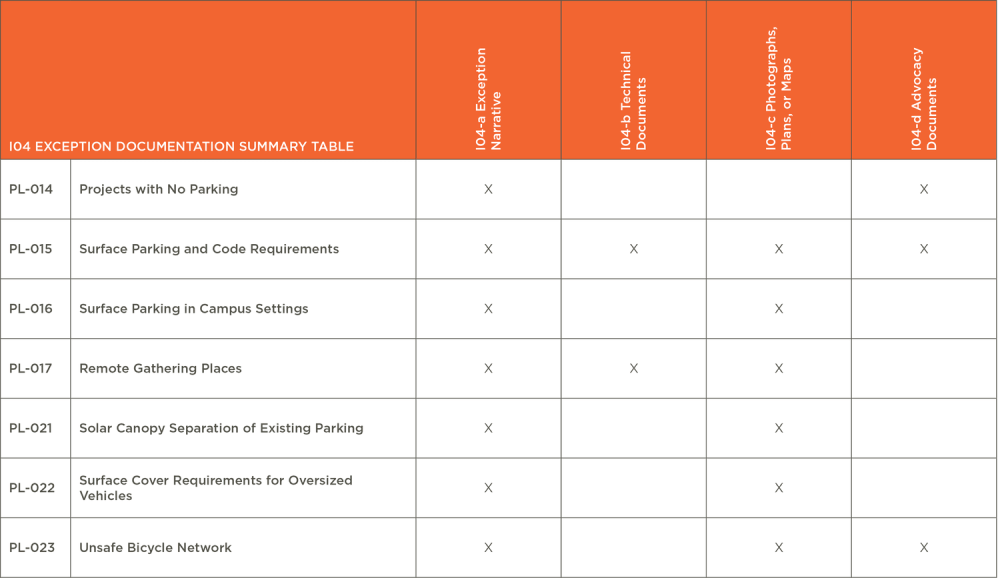BASIC DOCUMENTATION
I04-1 Density Documentation
READY AUDIT
Calculations that show Project Area FAR before and after the project or images that clearly show that the project has increased the density from the original condition.
I04-2 Human Scale and Human Powered Documentation
READY AUDIT
- Minimum one-page narrative describing how the project has addressed Imperative requirements and promotes pedestrian-oriented communities and human-powered transport.
- Plan indicating location and dimension of spaces available for community gathering.
- Plans showing the location(s) of compliant storage for human-powered vehicles.
- Plans showing the location(s) of facilities to encourage human-powered transit.
- Documentation showing the amount of compliant storage for human-powered vehicles according to the approach taken.
- Calculations showing the bicycle parking for the site based on design occupancy; or
- Alternative Pathway 1: Doubling the Documented Rate:
- Data showing the rate of commute cycling in the local area of the project, with a complete citation of the data source and date; and
- Calculation showing the bicycle parking for the site based on the cited data; or
- Alternative Pathway 2: Bicycle Friendly Business
- If the project has used the Bicycle Friendly Business Path for Bicycle Storage and/or Facilities to Encourage Human-Powered Transit:
- A copy of the award and assessment from the League of American Bicyclists, showing a strong rating for the Engineering section, or from an approved international equivalent.
I04-3 SOV Reduction/Best Practices Documentation
READY AUDIT
A narrative describing the approach to minimum 30% reduction in SOV and fossil fuel–based trips or the four best practices employed along with documentation as follows:
Minimum 30% reduction in SOV and fossil fuel–based trips:
- A description of the strategies for accomplishing the reduction, including specification of the baseline referenced. Documentation of the baseline must also be provided.
Minimum four best practices documentation:
- If the project has implemented four best practices, the following documentation must be provided in addition to the narrative, according to the practices selected:
- Advocacy to AHJ: Evidence of advocacy to promote a human-powered community, such as testimony to elected officials or a letter to the appropriate local jurisdictional authority and any replies from AHJ.
- Consideration and enhancement of pedestrian routes: Measures reflecting consideration and enhancement of pedestrian routes should be documented via plan drawings and photographs, with a short narrative on the design approach.
- Access either to subsidized car sharing and/or to hybrid or EV fleet vehicles: Evidence of access, such as a policy, lease agreements, or external partner agreement.
- Walk Score: Evidence from Walk Score that the project is located in a ZIP/postal code that has a Walk Score of at least 90.
- Bike Score: Evidence from Walk Score (Walk Score is the organization that develops the Bike Score) that the project is located in a ZIP/postal code that has a Bike Score of at least 90.
- Transit Score: Evidence from Walk Score (Walk Score is the organization that develops the Transit Score) that the project is in a ZIP/postal code that has a Transit Score of at least 90.
Single-family homes:
- A narrative describing the assessment to reduce the home’s transportation impact and the minimum two strategies planned for reducing the impact.
FINAL AUDIT
If the project is documenting a minimum 30% reduction in SOV and fossil fuel-based trips:
- A narrative describing implementation of the reduction strategy.
- Calculations showing a reduction of at least 30% in SOV trips and trips by fossil fuel-based vehicles to the building.
If the project is documenting implementation of four best practices, and:
- the project has conducted a survey, provide the initial survey of current SOV and fossil fuel-based trips, including a description of how it was administered and the results, and opportunities to further reduce SOV and fossil fuel-based trips.
- the project has provided a transit subsidy, provide documentation demonstrating to whom it is available, how availability of the subsidy is communicated, and that the amount meets the threshold specified in I04 Clarifications.
Single-family homes:
- A narrative describing the efforts to reduce the transportation impact, including any departures from the strategies originally planned, and an analysis of the results.
I04-4 Parking Documentation
READY AUDIT
- Dimensioned drawings showing the location and area of the following:
- Total impervious and pervious surface parking area.
- Expanses of surface parking before interruption by plantings.
- Gathering areas.
- Human-powered-vehicle storage.
- EV parking spot(s).
- Calculations demonstrating that total surface parking does not exceed maximum allowed percentage of the Project Area.
- Photos supporting the above drawings.
I04 Case Study
FINAL AUDIT
A summary narrative describing the project team’s approach to the Imperative, highlighting any lessons learned or particularly rewarding outcomes.
EXCEPTION DOCUMENTATION
Projects that use Exceptions or compliance paths that are not standard for all projects must submit additional documentation per the table below. Unless the exception is tied to the 12-month performance period, all Exception documentation must be submitted at the Ready Audit.

I04-a Exception Narrative
A narrative describing the project’s need for the Exception, the approach to and implementation of the alternative solution, and including any specific eligibility, analysis, or other requirements specified in the Exception. Where required in the Exception language, calculations must be included here.
I04-b Technical Documents
An official document, statement of policy or code, permit applications, or other documentation that relate to the Exception requirements and document that the Exception requirements have been met.
103-c Photographs, Plans, or Maps
Visual evidence that Exception requirements have been met.
I04-d Advocacy Documents
A copy of the communication sent to the AHJ or other mandating authority requesting a variance or other change to their policy or code as well as the reply from the AHJ. Projects using PL-023 Unsafe Bicycle Network must also provide documentation of public testimony as specified in the the Exception language.



